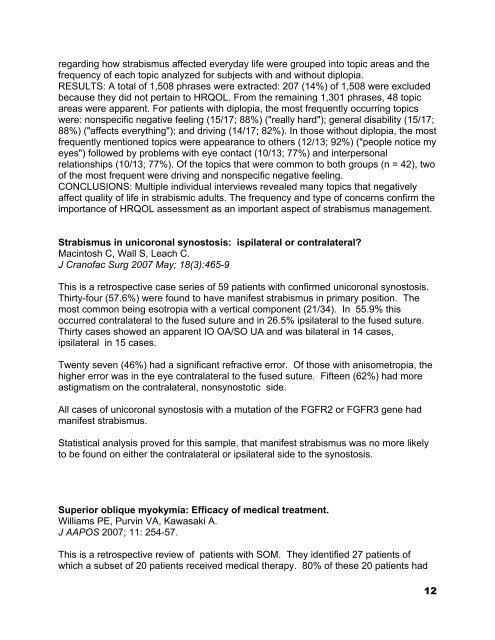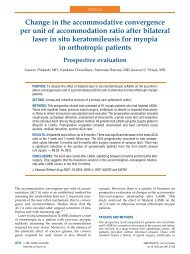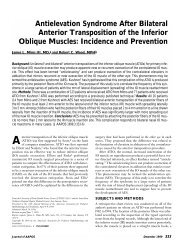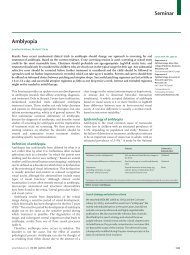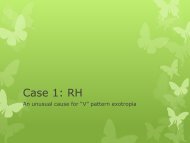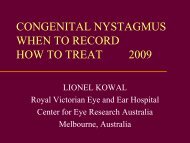What's new AAPOS 2008 - The Private Eye Clinic
What's new AAPOS 2008 - The Private Eye Clinic
What's new AAPOS 2008 - The Private Eye Clinic
Create successful ePaper yourself
Turn your PDF publications into a flip-book with our unique Google optimized e-Paper software.
egarding how strabismus affected everyday life were grouped into topic areas and the<br />
frequency of each topic analyzed for subjects with and without diplopia.<br />
RESULTS: A total of 1,508 phrases were extracted: 207 (14%) of 1,508 were excluded<br />
because they did not pertain to HRQOL. From the remaining 1,301 phrases, 48 topic<br />
areas were apparent. For patients with diplopia, the most frequently occurring topics<br />
were: nonspecific negative feeling (15/17; 88%) ("really hard"); general disability (15/17;<br />
88%) ("affects everything"); and driving (14/17; 82%). In those without diplopia, the most<br />
frequently mentioned topics were appearance to others (12/13; 92%) ("people notice my<br />
eyes") followed by problems with eye contact (10/13; 77%) and interpersonal<br />
relationships (10/13; 77%). Of the topics that were common to both groups (n = 42), two<br />
of the most frequent were driving and nonspecific negative feeling.<br />
CONCLUSIONS: Multiple individual interviews revealed many topics that negatively<br />
affect quality of life in strabismic adults. <strong>The</strong> frequency and type of concerns confirm the<br />
importance of HRQOL assessment as an important aspect of strabismus management.<br />
Strabismus in unicoronal synostosis: ispilateral or contralateral?<br />
Macintosh C, Wall S, Leach C.<br />
J Cranofac Surg 2007 May; 18(3):465-9<br />
This is a retrospective case series of 59 patients with confirmed unicoronal synostosis.<br />
Thirty-four (57.6%) were found to have manifest strabismus in primary position. <strong>The</strong><br />
most common being esotropia with a vertical component (21/34). In 55.9% this<br />
occurred contralateral to the fused suture and in 26.5% ipsilateral to the fused suture.<br />
Thirty cases showed an apparent IO OA/SO UA and was bilateral in 14 cases,<br />
ipsilateral in 15 cases.<br />
Twenty seven (46%) had a significant refractive error. Of those with anisometropia, the<br />
higher error was in the eye contralateral to the fused suture. Fifteen (62%) had more<br />
astigmatism on the contralateral, nonsynostotic side.<br />
All cases of unicoronal synostosis with a mutation of the FGFR2 or FGFR3 gene had<br />
manifest strabismus.<br />
Statistical analysis proved for this sample, that manifest strabismus was no more likely<br />
to be found on either the contralateral or ipsilateral side to the synostosis.<br />
Superior oblique myokymia: Efficacy of medical treatment.<br />
Williams PE, Purvin VA, Kawasaki A.<br />
J <strong>AAPOS</strong> 2007; 11: 254-57.<br />
This is a retrospective review of patients with SOM. <strong>The</strong>y identified 27 patients of<br />
which a subset of 20 patients received medical therapy. 80% of these 20 patients had<br />
12


